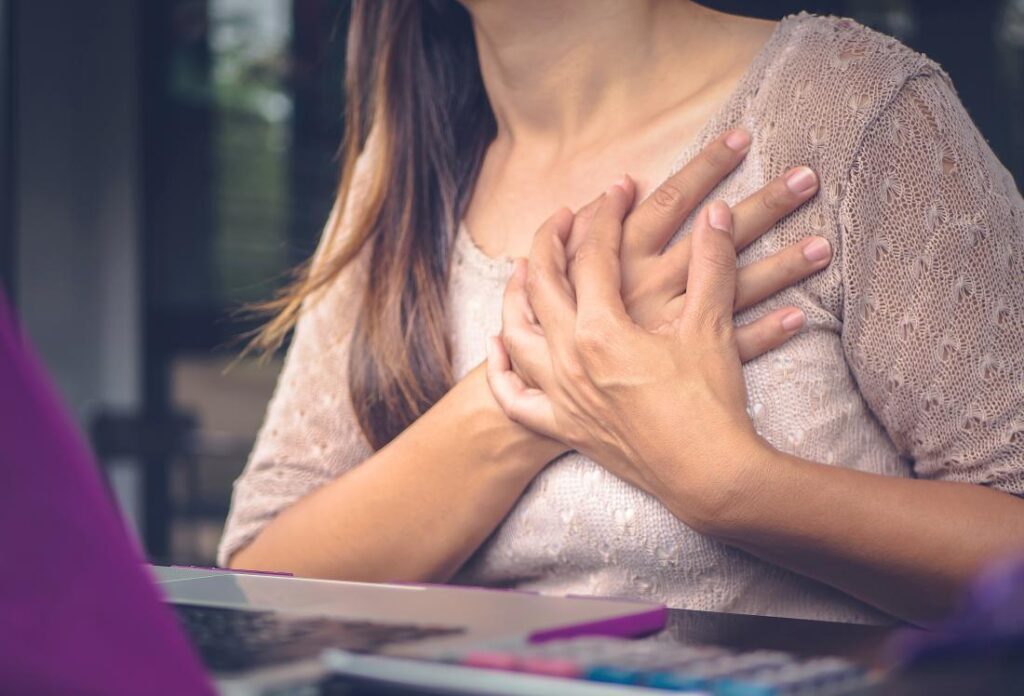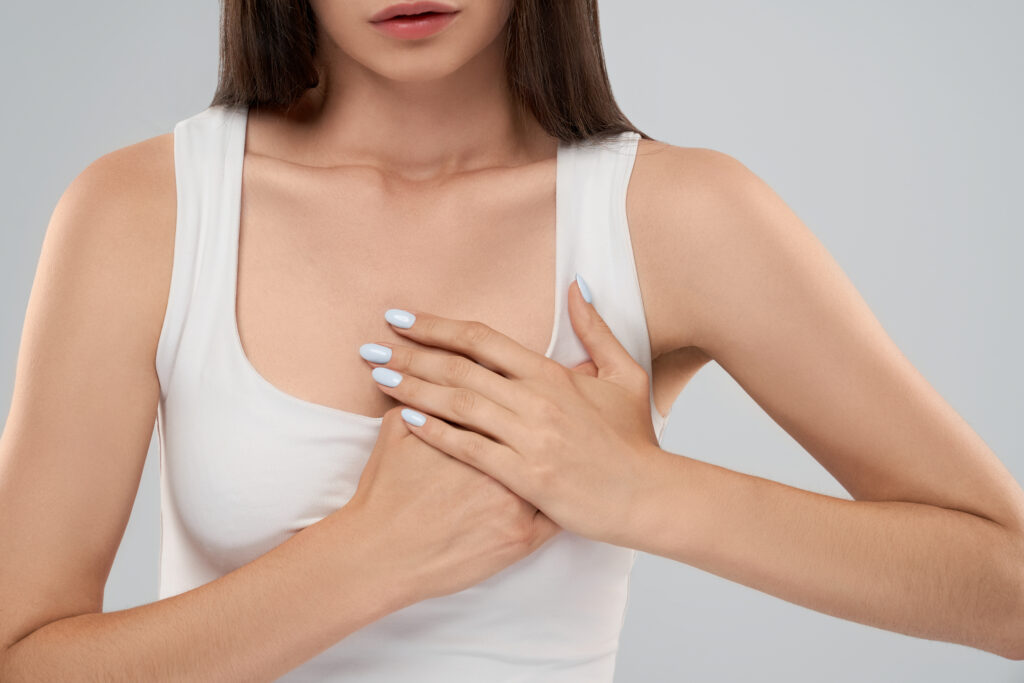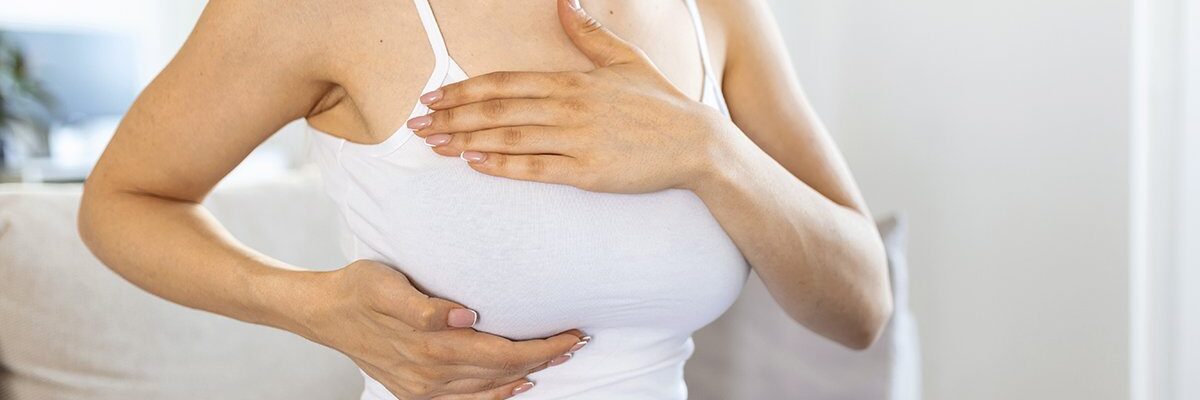Overview
Breast pain, or mastalgia, is a common symptom experienced by many women at different stages of their lives. The discomfort can occur in one or both breasts and may range from mild to severe. Some women describe it as a dull ache, sharp pain, or a sense of heaviness. While breast pain can be unsettling, it is often not a sign of a serious condition and can be managed with appropriate care.
There are two main types of breast pain: cyclic and non-cyclic. Cyclic breast pain is linked to hormonal changes during the menstrual cycle, making it more common in women of reproductive age. This type of pain often follows a predictable pattern, increasing in intensity before menstruation and subsiding afterward. Non-cyclic breast pain, on the other hand, is unrelated to hormonal changes and may result from factors like injury, infections, or underlying breast conditions.
While breast pain is usually benign, it’s essential to understand its possible causes to address concerns and determine when to seek medical attention. Persistent or severe pain, especially if accompanied by lumps, changes in breast size or shape, or nipple discharge, may require further evaluation to rule out serious conditions. By identifying the underlying cause, women can take steps to manage their symptoms and maintain breast health.
Table of Contents
Possible Causes of Breast Pain

Breast pain, or mastalgia, can result from a variety of factors, ranging from hormonal changes to more serious medical conditions. Below are the most common causes, their symptoms, and treatment options:
- Hormonal fluctuations. Changes in estrogen and progesterone levels during the menstrual cycle can cause cyclic breast pain, typically felt as tenderness or heaviness. This pain usually subsides after menstruation. Over-the-counter pain relievers and lifestyle changes, such as reducing caffeine and salt intake, can help manage symptoms.
- Pregnancy. Hormonal changes during pregnancy can lead to breast tenderness, particularly in the early stages. Wearing a supportive bra and staying hydrated may alleviate discomfort.
- Breastfeeding complications. Conditions such as mastitis (breast infection) or clogged milk ducts can cause localized pain, redness, and swelling. Treatment often involves antibiotics, warm compresses, and proper breastfeeding techniques.
- Fibrocystic breast changes. This non-cancerous condition involves the development of lumpy or rope-like breast tissue, leading to pain and sensitivity. Reducing caffeine intake, wearing supportive bras, and using over-the-counter pain relief can help.
- Breast injury. Trauma to the breast, such as from an accident or sports, can result in pain and bruising. Rest, ice application, and pain relievers are typically effective treatments.
- Infections. Infections like mastitis, commonly associated with breastfeeding, cause pain, redness, swelling, and sometimes fever. Prompt treatment with antibiotics is usually necessary.
- Breast cysts. Fluid-filled sacs within the breast tissue can cause pain or tenderness, particularly if they become large or press against nearby tissue. Ultrasound-guided drainage may be required in some cases.
- Medications. Certain medications, such as hormonal treatments, oral contraceptives, or antidepressants, can cause breast pain as a side effect. Consulting a doctor to adjust the medication or dosage may help.
- Poorly fitting bras. Wearing bras that lack proper support or are too tight can strain breast tissue and cause discomfort. Switching to a well-fitted, supportive bra can resolve the issue.
- Breast cancer. Although less common, pain can be a symptom of inflammatory breast cancer or other malignancies, especially if accompanied by changes in breast size, shape, or skin texture. A medical evaluation is crucial for early diagnosis and treatment.
Understanding the possible causes of breast pain can help identify appropriate treatments and prevent unnecessary worry. If the pain persists, worsens, or is associated with other concerning symptoms, seek medical advice for proper diagnosis and care.
Conditions Associated with Breast Pain

Breast pain, or mastalgia, can be linked to various medical conditions. While many of these conditions are benign, some may require medical attention. Below are the most common conditions associated with breast pain:
- Fibrocystic breast changes. This benign condition involves lumpy or rope-like breast tissue that can cause pain, especially before menstruation. Symptoms include tenderness and swelling, and treatment often includes lifestyle changes and over-the-counter pain relievers.
- Mastitis. This breast infection, common in breastfeeding women, leads to localized pain, redness, swelling, and fever. Treatment typically involves antibiotics and warm compresses.
- Breast cysts. Fluid-filled sacs in the breast tissue can cause pain, particularly if they grow large or press against surrounding tissue. Ultrasound-guided drainage may be needed for relief.
- Hormonal fluctuations. Changes in estrogen and progesterone levels during the menstrual cycle often result in cyclic breast pain. This pain is common in women of reproductive age and usually resolves after menstruation.
- Pregnancy. Hormonal shifts during pregnancy can lead to breast tenderness and sensitivity, especially in the first trimester. Wearing supportive bras and staying hydrated can help manage this discomfort.
- Poorly fitting bras. Ill-fitting bras can strain breast tissue, causing pain and discomfort. Switching to a well-fitted, supportive bra usually resolves the issue.
- Breastfeeding complications. Issues such as clogged milk ducts or engorgement can cause significant pain. Proper breastfeeding techniques and warm compresses can alleviate symptoms.
- Breast trauma. Injuries to the breast from accidents or sports can result in localized pain and bruising. Rest, ice application, and pain relievers are effective treatments.
- Inflammatory breast cancer. Though rare, this aggressive form of breast cancer can cause pain along with redness, swelling, and skin changes. Early medical evaluation is critical for diagnosis and treatment.
- Costochondritis. This condition, involving inflammation of the cartilage connecting the ribs to the breastbone, can mimic breast pain. Treatment often includes anti-inflammatory medications and rest.
Understanding the conditions associated with breast pain can help in identifying the underlying cause and determining the best course of action. If breast pain persists or is accompanied by other concerning symptoms, consult a healthcare provider for proper evaluation and management.
When to See a Doctor
Breast pain is often harmless and may resolve on its own, but there are situations where medical evaluation is essential. Here are some instances when you should consult a doctor for breast pain:
- Persistent pain. If breast pain lasts for more than a few weeks despite home remedies or lifestyle changes, it could indicate an underlying condition that needs medical attention.
- Severe pain. Intense or debilitating breast pain that interferes with daily activities may require further investigation.
- Pain in one breast only. Unilateral breast pain that is not associated with the menstrual cycle warrants evaluation, as it may be linked to cysts, infections, or other conditions.
- Presence of lumps. If breast pain is accompanied by a new or unusual lump, it is essential to have it checked to rule out serious conditions such as breast cancer.
- Skin changes. Redness, dimpling, thickening of the skin, or other visible changes on the breast could indicate an infection or inflammatory breast cancer.
- Nipple discharge. Unusual discharge, especially if it is bloody or occurs without squeezing, should be assessed by a healthcare professional.
- Fever or signs of infection. Breast pain associated with fever, redness, or warmth may indicate mastitis or another infection requiring antibiotic treatment.
- Pain unrelated to the menstrual cycle. Non-cyclic breast pain, particularly in postmenopausal women, may be linked to other conditions and should be evaluated.
What Type of Doctor to Seek
For breast pain, consider consulting:
- A general practitioner or family doctor for initial assessment.
- A gynecologist for hormone-related or menstrual cycle-linked breast pain.
- A breast specialist or surgeon if lumps, discharge, or other abnormalities are present.
What to Expect From Your First Doctor Visit
During your visit, the doctor may:
- Take a detailed history. Be prepared to discuss your symptoms, menstrual cycle, lifestyle, and any recent changes.
- Perform a physical examination. This will include a thorough breast exam to check for lumps, skin changes, or tenderness.
- Order diagnostic tests. These may include imaging tests like mammograms, ultrasounds, or, in some cases, a biopsy to rule out serious conditions.
Early medical evaluation can help determine the cause of breast pain and guide effective treatment. If you are unsure about your symptoms, it is always better to consult a healthcare provider for peace of mind and proper care.
Breast Pain FAQs
Breast pain, or mastalgia, is a common concern for many women. Below are answers to frequently asked questions about its causes, symptoms, and treatments.
- What causes breast pain?
Breast pain can result from hormonal changes during the menstrual cycle, pregnancy, or menopause. Other causes include fibrocystic breast changes, infections, poorly fitting bras, injuries, or medical conditions like mastitis or breast cysts. - Is breast pain a sign of breast cancer?
Breast pain is rarely a symptom of breast cancer. However, if it is accompanied by lumps, skin changes, or unusual nipple discharge, consult a doctor for evaluation. - When should I worry about breast pain?
Seek medical advice if the pain is persistent, severe, localized to one breast, or accompanied by other symptoms like lumps, redness, fever, or nipple discharge. - How is breast pain treated?
Treatment depends on the cause and may include over-the-counter pain relievers, warm or cold compresses, wearing supportive bras, adjusting hormone medications, or antibiotics for infections. - Can hormonal changes cause breast pain?
Yes, hormonal fluctuations during the menstrual cycle are one of the most common causes of cyclic breast pain. This type of pain typically subsides after menstruation. - Can men experience breast pain?
Yes, men can experience breast pain, often due to gynecomastia (enlarged breast tissue), hormonal imbalances, or trauma to the chest area. - Does stress contribute to breast pain?
Stress does not directly cause breast pain but can worsen the perception of pain. It may also contribute to hormonal imbalances, which can indirectly lead to discomfort. - Can wearing the wrong bra cause breast pain?
Yes, poorly fitting bras that lack proper support can strain breast tissue and cause discomfort. Wearing a well-fitted bra can help alleviate pain. - Are there lifestyle changes to reduce breast pain?
Yes, reducing caffeine and salt intake, maintaining a healthy weight, wearing supportive bras, and avoiding high-impact activities without proper support can help reduce breast pain. - Can breast pain be related to breastfeeding?
Yes, breastfeeding can cause pain due to issues like engorgement, mastitis, or clogged milk ducts. Proper latching techniques, warm compresses, and consulting a lactation specialist can help.
Understanding the potential causes and treatments for breast pain can alleviate concerns and improve comfort. If symptoms persist or worsen, consult a healthcare professional for proper diagnosis and care.


